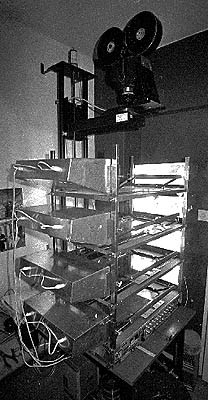Stop-Motion Animation Reflection
Reflecting on my first attempt at a stop-motion animation film.

I contracted my 2D Animation and Asset Production course for Honors credit, and was assigned to make a stop-motion animation over the course of the semester. After planning, shooting, and editing, here is the final product:
Summary and Reflection
My original plan for this project was to shoot a "reenactment" of the creation of the world through the Latin narrative poem Metamorphoses by the Roman poet Ovid. After planning and storyboarding the shot several times, I broke the plan down to such a loose idea that when I got working on set I was basically improvising. I wanted to keep with the creation of the world idea, but lighten the mood and humble the tone.
Initially I planned to suspend all the objects (the clouds, the sun, the earth) on string and shoot horizontally against a green-screen then edit in the backdrop. After making an animatic of the scenes in Adobe Flash I had the idea of parallaxing the ground and making a progressive story where the "god" figure populates the already created earth. My professor brought in some old dusty windows she had lying around in her garage, and we polished them up and set up a shoddy home-made version of a classic Disney multiplane camera:

I used the green-screen for the grass/ground and a blue tablecloth for the sky, then constructed the props with clay. I manually moved all the props and green cloth each shot. I've decided to reflect on this work by defining 5 things I learned about art, photography, animation, stop-motion, or anything related.
1. You Can't Rush Art
It has to be said hundreds of times because it really is difficult not just to understand, but to execute. I remember clearly my professor's warning that "things will move faster than you think they will" after shooting. I needed to take my time and slow the pace of animation. And in all honesty, I really thought I did. I really thought I was taking my time and moving slowly. The plan was to render at 10 frames per second; my final cut is rendered at 5 frames per second. I literally shot half as many shots as I should have. As much as I wanted to see my ideas come to life and move on to other equally exciting shots it's important for the good of the final product to stay focused, calm, and detailed.
2. Attention to Detail
...is something that doesn't come naturally to me, and I would guess doesn't come naturally to a lot of people. But missing the little things becomes very apparent in something as focused as a stop-motion film. The color and brightness of light needed to be stable in every single shot. Smudges from clay on the window glass reflected the light around and caused glares all over the place. The camera shifted all the time, even just from people walking around the lab. On top of that, if the camera gets shifted and the stage gets shifted the result is disastrous even though the cause was minor. Even little changes like the backdrop tablecloth being folded in a corner during one frame can cause major issues with single shots. Allocating lots of time and space to shoot can leave room for taking your time and paying attention to the little things.
3. You Can't Revise a Shot
At least, not easily. I shot for close to 10 hours each day for 2 days over a weekend, then edited the images after importing them to AfterEffects. Most of the shots just needed to have their levels adjusted slightly, but on some, colored light or reflected light made repairing the image extremely difficult. You can rush through an essay on a computer, then read through it again and correct errors and add in content you left out. But with a process like recording or photographing footage, you shoot and edit, and editing is a limited thing. Shooting for stop-motion was more like writing on paper, where I could go back and cross-out errors and white-out words but sometimes the corrections are noticeable or inadequate.
4. Improvising Can Be Fun
I had a really solid plan for my project, but when I changed the entire stage around mechanically I had to adapt. I could have evolved my arranged plan for a new setting but I felt that the window-pane stage did not adequately portray what I wanted to portray by suspending props. I kept a lot of the ideas, but for the most part, I was just playing with my imagination. For 9 years I played and taught guitar and my absolute favorite thing to do was improvise. You have a given scale you are restricted to, but you listen to the melody in your head and move your fingers to make the sounds. In the same way, I pictured scene after scene of my film, broke it down to frames in my head, and made the props and motions on the spot. The process became imaginative fun over tedious work, and I think ended up more playful than the original idea, though possibly slightly less cohesive.
5. Dive Into New Things
I made a few stop-motion animations with my friends when I was really young using LEGO figures. I'm sort-of capable of animating, and consider myself a poor visual artist in general, but I didn't have a problem taking a leap into something I'm not comfortable doing like I am comfortable with coding or balancing game systems. You learn quickly if you are willing to try and fail and reflect, and that's exactly what I did with my stop-motion. My original storyboard was an overshot, and my planning for the set was probably inadequate. I'm very very rusty and uncomfortable editing images (colorizing, adjusting levels, stabilizing, etc.), and I still feel like there's work to be done to make my film better. But I'm still proud of it, because I know that I learned a lot, and that I still saw the project through to the end despite the fact that I'm usually a perfectionist. Normally I scrap projects as soon as I feel they aren't going exactly as I foresee, but the nature of making a stop-motion movie prevented me from doing that. I had to do this project step by step and I had to acknowledge the fact that I would have to adapt to imperfections, and in the end I created something worth being proud of.
Thanks for reading.
~ Wes
Read more about:
BlogsAbout the Author
You May Also Like









